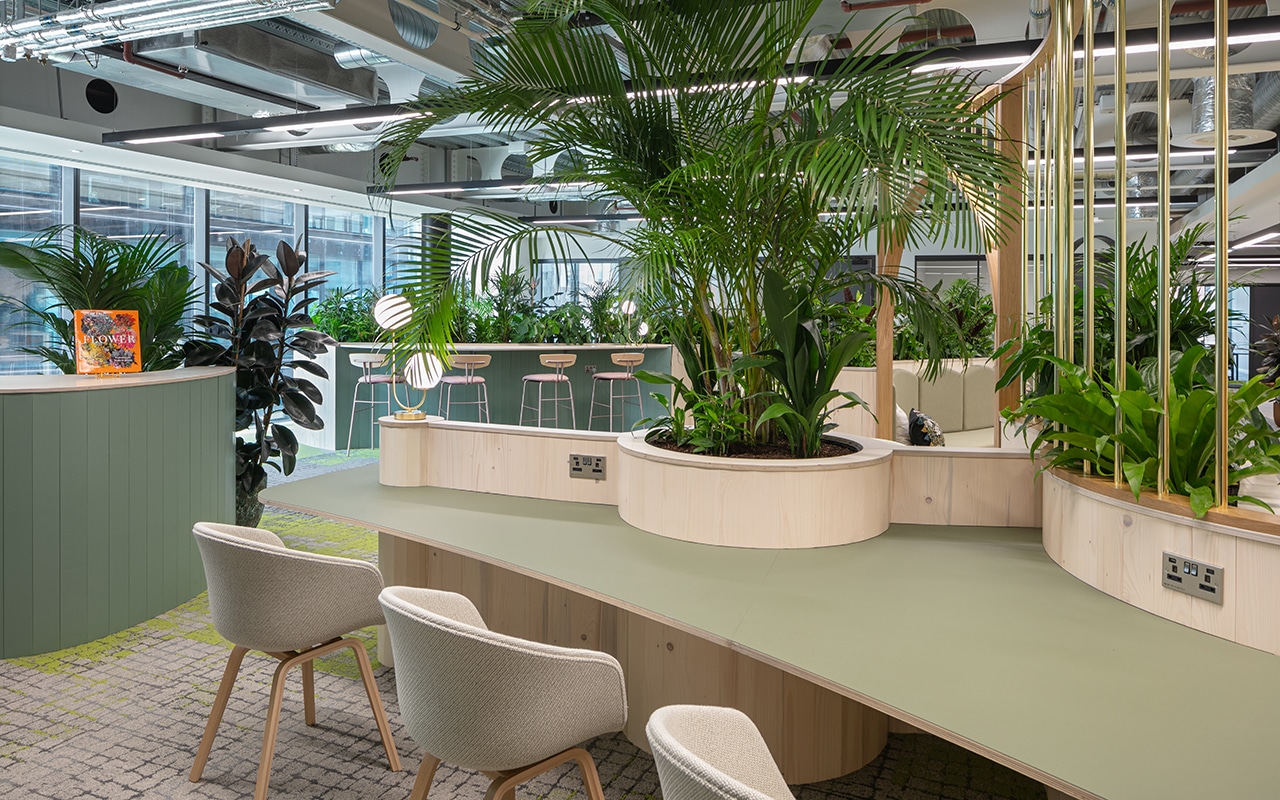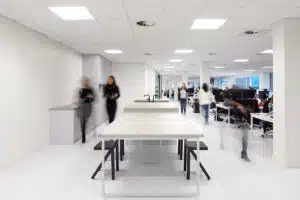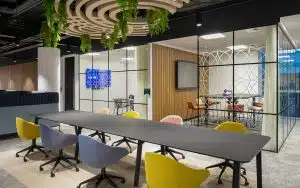German psychologist, Erich Fromm, was the first to coin the term biophilia, defined in 1973 as, “the passionate love of life and of all that is alive”. It refers to the innate human desire to connect with nature, and in architecture, centres around bringing the outdoors indoors to create environments that foster human wellbeing.
With increasing emphasis on the physical and mental health of employees in the workplace, biophilic office design actively integrates elements of nature to create more pleasant, inspiring, and healthy work environments.
This style of natural design improves employee wellbeing, satisfaction, productivity and creativity, and is gaining traction in the office to help offset the pressures and demands of fast-paced, digital workplaces.
Biophilic design principles
Biophilic design in the workplace is about more than just introducing plants, although this is perhaps one of the more obvious and popular solutions. Other biophilic design principles include:
- Maximising natural light and views of the outdoors – incorporating large windows, glass doors, panels or partitions and skylights can help with this
- Providing access to outdoor space like roof gardens, balconies and gardens. Incorporating comfortable furniture into outdoor spaces so employees can utilise this as another work area will further improve wellbeing
- Selecting an earthy and calming colour palette, like greens, blues, browns and yellows
- Utilising natural features, materials and textures like wood, stone and grass to help mimic the outdoors
- Including water features or elements such as fountains, ponds, or water walls – the sight and sound of water can have a calming effect on employees
- Incorporating natural shapes and forms – biophilic design architecture is commonly associated curved lines, arches and domes
Biophilic designs in the workplace
There are many different reasons why organisations introduce biophilic office design, including:
- Improving air quality, ventilation and natural lighting: Providing access to the correct levels of fresh air, ventilation and natural light benefits employee wellbeing, but is often where many modern workplaces fall short.
The World Health Organisation estimates that poor indoor air quality affects approximately 30% of office buildings. This is significant when you consider that the typical office-based employee will spend around eight hours in their workplace each day. Biophilic design is an effective way to address this.
- Creating office ‘neighbourhoods’: Modern office design concepts establish office ‘neighbourhoods’ or ‘clusters’ by organising different areas within a larger space into smaller zones or working environments, each serving specific teams or functions.
Office neighbourhoods intend to create more efficient work environments while fostering collaboration and a sense of community and connection. Just as typical neighbourhoods are often sectioned by green spaces, plants and trees, biophilic workplace design mimics this in an office environment to help encourage social interaction, creativity and relaxation. Organisations can easily reconfigure areas like this to accommodate changing needs, preferences, and dynamics as they evolve
- Giving employees a reason to come back into the office: With many companies adopting hybrid working models, and employees proving they can work efficiently at home, there’s a greater need to incentivise employees to come into the office so businesses can foster culture and collaboration.
According to our market research of UK office workers, the average person who travels to the office five days a week spends almost 13 days a year commuting, so the experience you provide needs to justify their commute. Biophilic design actively creates a more attractive, aesthetically pleasing workplace that employees will enjoy spending time in. - Biophilia can also encourage connection, collaboration and innovation between teams and colleagues to enhance productivity.
Restoration and wellbeing: Biophilic office design, sometimes referred to as biophilia design, with its proven restorative qualities, can create serenity to help offset the stresses of the modern digital workplace.
Benefits of biophilic office design
Linking both employee wellbeing and business performance, the benefits of biophilia in the workplace include:
- Increased productivity and concentration. Biophilia increases oxygen levels and reduces mental fatigue to improve concentration, cognitive function and output. Better indoor air quality alone, with increased ventilation and lower levels of CO2 and pollutants, reduces the risk of respiratory issues and improves productivity by 8-11%, while natural light supports circadian rhythms and healthy sleep patterns
- Better collaboration, creativity and innovation. Biophilia in office design is stimulating and conducive to creativity and innovation, helping employees to engage with each other and their surroundings
- Reduced stress and absenteeism. Just introducing plants into the office can reduce stress and absenteeism by 50%.
- Better team morale, company culture and workplace satisfaction, contributing to talent attraction and retention. If employees have a comfortable and inviting work environment that allows them to thrive, they’re less likely to want to move on
- Enhanced comfort through flexibility and choice. Employees can work where and how they want to reduce distractions and boost productivity
- Supporting neurodiverse colleagues. Incorporating biophilia in workplace interior design can help to reduce distractions and sensory overload
Biophilic designs we love
Increasingly innovative biophilic designs and products are helping to create better and more effective office experiences across the world. Some stand-out examples include:
- Meta’s MPK 21: Facebook’s HQ in Menlo Park features large windows to let in natural light, wooden beam panels and furniture. Also home to over 200 trees, a half mile walking path and 3.6 acres of rooftop garden for employees to enjoy
- Amazon Seattle Spheres: 58,828 sq.ft with four waterfalls, fish tanks, terrariums, and over 40,000 plants – in the middle of Seattle. Initially built to provide a serene workplace for employees, the Spheres are now often opened up for the public to enjoy as well
- Apple Park: Set across 175 acres and home to 12,000 employees, Apple’s Californian headquarters is the largest naturally ventilated building and features 9,000 drought-resistant trees and one of the world’s largest panels of curved glass
Final thoughts
The design choices companies make actively improve employee experiences and drive a wider positive impact on productivity and business performance. Biophilic design in the workplace is a prime example, helping to bridge the gap between the office and the natural world to boost employee health, happiness and wellbeing, and simultaneously, the bottom line.
However, to maximise its potential and investment, companies need to introduce biophilic design as part of a carefully considered workplace strategy , which they can create in partnership with an experienced workplace design consultancy.
At ADT Workplace, we’re passionate about creating office designs that deliver real business value and where people love to work. To take the first step in your company’s journey to reigniting your workspace with biophilic design, or for more information, get in touch.




